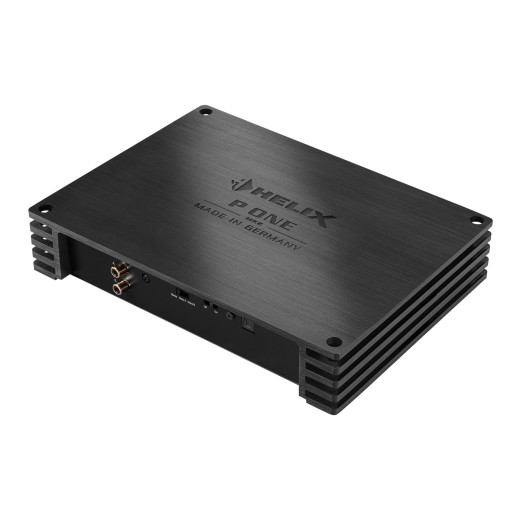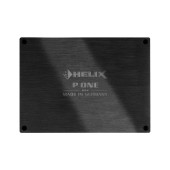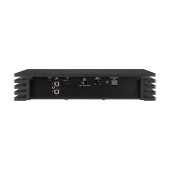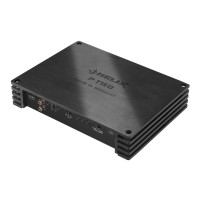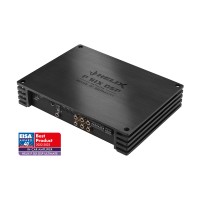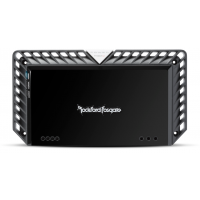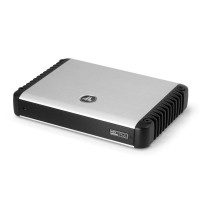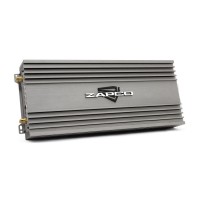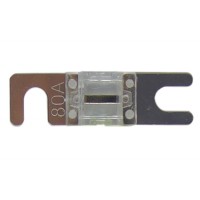Helix P One amplifier
More about the product
- You can return the goods to us within 14 days
Helix P One Amplifier
Plenty of power and enormous stability. The Helix P One MK2 is an ideal high-power amplifier for any subwoofer. With up to 1800 W RMS @ 1 ohm, the Helix P One can drive any woofer while maintaining full control thanks to an extremely high damping factor. However, the P One is designed for more than just driving subwoofers. With its unusually wide frequency response up to 40 kHz, excellent signal-to-noise ratio, and extremely low THD, you can expect nothing less than high-resolution sound quality—making it well suited for use as a full-range amplifier. The built-in optical digital input allows uninterrupted transmission of the signal in the best possible quality to the amplifier. The input accepts signals losslessly up to a 96 kHz sampling rate and converts them back to analog using a top-of-the-line 32-bit BurrBrown D/A converter.
Main features
- High-power mono Class D amplifier with up to 1800 W RMS @ 1 ohm.
- High-resolution capability thanks to an extended audio frequency response beyond 40 kHz for unparalleled sound quality.
- Extremely high efficiency and low heat dissipation in a compact size.
- High damping factor for maximum speaker control.
- Digital optical SPDIF input including an SPDIF Direct In switch for routing the digital input signal.
- Latest-generation BurrBrown 32-bit D/A signal converter.
- Switchable subsonic filter.
- Regulated power supply with Start-Stop capability for extremely stable output power even during voltage drops.
- SMD (Surface Mounted Device) manufacturing technology combines minimal space requirements with maximum reliability.
- Input mode switch to adapt the amplifier to the input signal.
About the brand
HELIX by Audiotec Fischer is a German brand of premium car audio equipment that has been among the world’s leaders in amplifiers and DSP processors for more than 35 years. HELIX is regarded as a leader in digital signal processors and offers some of the most advanced, highest-quality DSP units in the world, enabling an experienced technician to tune any audio system to perfection and bring an authentic hi‑fi experience into the car. The combination of precise German engineering, state-of-the-art technologies, and innovative design delivers clean, dynamic, and detailed sound that has earned the admiration of audiophiles worldwide. HELIX products are characterized by high efficiency, reliability, and perfect integration into modern vehicles. These products are an ideal choice for demanding users who require the best possible sound without compromise. Helix, together with the Brax and Match brands, falls under the German manufacturer Audiotec Fischer.
| Catalog number | P81001 |
| Brand | Helix |
| Links | Official web presentation |
| Number of amplifier channelsAmplifiers are divided into: - Monoblocks - 2-channel - 3-channel - 4-channel - 5-channel - 6-channel - multi-channel Each channel is used to power one speaker for the coaxial type, or one side if they are component speakers. Monoblock type amplifiers are mainly used for subwoofers. 2-channel are suitable for both subwoofers and, for example, the front pair of speakers in a car. 3-channel is used for front or rear speakers + subwoofer. 4-channel are used for front + rear speakers or 1 pair of speakers + subwoofer. 6 or 5-channel are used for 2 pairs of speakers + subwoofer, most often. Bridging means connecting the amplifier to a bridge, using the + pole from one channel and the - pole from the other channel. In most cases this is shown as "BRIDGED" on the amplifier. | 1 |
| Energy class of the amplifierAmplifiers are divided into two basic classes: analog and digital . Analog amplifiers (A/B) have higher consumption requirements, but usually have a more natural sound. Digital amplifiers (D) have significantly lower consumption and higher efficiency, but the sound may not be as faithful as with classic analog amplifiers. | D |
| RMS power into 4 ΩRMS power when loading speakers or subwoofer at 4 Ω. RMS power is the constant power of the amplifier and is one of the most important parameters when choosing an amplifier. | 1 x 500W |
| RMS power into 2 ΩRMS power when loading speakers or subwoofer at 2 Ω. RMS power is the constant power of the amplifier and is one of the most important parameters when choosing an amplifier. | 1 x 880W |
| RMS power into 1 ΩRMS power when the subwoofer is loaded at 1 Ω. RMS power is the constant power of the amplifier and is one of the most important parameters when choosing an amplifier. When connected to 1 Ω, significant heating of the amplifier may occur. | 1 x 1500W |
| Inputs | 2 x RCA, 1 x Remote In, 1 x optical SPDIF |
| Outputs | 1 x speaker output |
| Frequency rangeThe ability of the amplifier to reproduce the signal from the lowest frequency to the highest = faithfully reproduce the sound in a specific frequency band. Professionally: In the frequency range from 40 to 16,000 Hz, the vast majority of fundamental and overtones (harmonics) of all musical instruments are found. We are interested in the course of the radiated sound pressure in this range of frequencies when the loudspeaker system is supplied with constant power. We call this course the frequency characteristic, which tells us the level of radiated sound pressure in decibels (dB) depending on the frequency. The frequency characteristic of a speaker or speaker system can be expressed most succinctly with a graph. Mostly, however, the frequency characteristic is indicated by indicating the maximum tolerance of the sound pressure in the given frequency range, e.g. 50 to 15,000 Hz -+ 6 dB. Since the frequency characteristics of loudspeakers and systems in general are quite uneven, some manufacturers do not even specify this maximum tolerance of sound pressure in decibels in their catalogs for reasons of prestige. Data impoverished in this way is unfortunately worthless. What is valid is that the manufacturer offers a speaker system with a frequency range of 30 to 20,000 Hz, if he is worried about stating the maximum unevenness of the sound pressure in this range, because he can have a tolerance of, for example, +- 20 dB. The unevenness or undulation of the frequency curve in good speaker systems for high-quality music performance should not exceed +-3 dB in the 80 to 12,000 Hz band and +-6 dB in the 40 to 16,000 Hz band. Greater unevenness already depletes or emphasizes certain tonal areas, which can cause audible or even disturbing distortion. The proportion between fundamental tones and higher harmonics also changes, thereby changing the color of the sound, and individual musical instruments as well as the entire musical image sound unnatural. | 21 - 40000 Hz |
| Harmonic Distortion (THD)Total harmonic distortion indicates how much the input signal is distorted in the amplifier. Distortions appear as overtones contained in the output signal. The proportion of originally absent parts of the signal is given as a percentage, typical values are between 0.001% and 0.5%. Distortion is measured in their power band. If it exceeds the limit of 0.7% from a certain power, it is the value of the output power of the given amplifier, from which it no longer plays without distortion and from which the distortion usually increases steeply, so that no further increase in power can be counted on. The lower the value, the better. | < 0.01% |
| Signal-to-noise ratioThe signal-to-noise ratio means that the output signal always contains noise. The signal-to-noise ratio expresses how much of this noise is compared to the useful signal. The so-called A value is given, which does not take deep and very high frequencies into account. This corresponds to the characteristic of human hearing, which is not so sensitive to deep frequencies, especially below 1 kHz. The higher the value, the better the amplifier is. | 110 dB |
| Damping factorDF - Damping Factor . It is the ratio of the load (repro + cables, crossover, etc.) to the internal resistance of the amplifier. The bigger the DF, the more controlled the bass. Amplifiers with a lower DF tend to hum. Subwoofers with a higher Q in the bass reflex and sometimes in the enclosure will also cause humming. | >450 |
| High level inputsThe high-level input on the amplifier allows connection directly to the existing speakers in the car without additional purchase of an external high/low adapter. Important equipment in the case of installing an amplifier on an original car radio. | Yes |
| Automatic on and offThis function allows you to automatically switch on the amplifier. | Yes |
| Socket input terminalsFerrule terminals allow better wiring contact to the amplifier. It is also a more secure form of terminals. If you are tightening the sleeve terminals, we recommend retightening them after 1 day, as the connected cable gradually compresses. | Yes |
| Remote control included in the packageSome models of amplifiers also come with wired remote controls in the package, which on one side plug into the amplifier and on the other side you have a potentiometer that you can place anywhere in the cabin. A common place to place the remote control is under the steering wheel. The advantage is the regulation of power, and therefore volume, depending on driving conditions and the mood of the crew in the car. | Yes |
| Input for wired remote controlIf the amplifier has a remote control input. | Yes |
| The value of the fuses on the amplifierFrom the value of the fuses on the amplifier, you can get a true picture of the real performance of the amplifier. | 4 x 30A |
| Dimensions of the amplifier | 50 x 260 x 190 mm |
